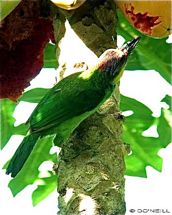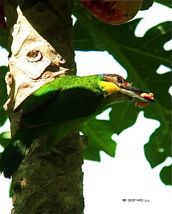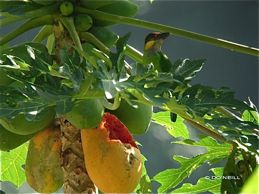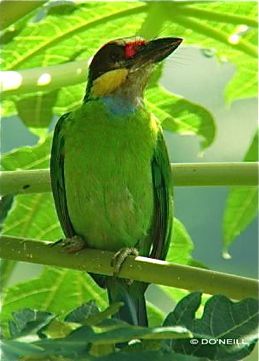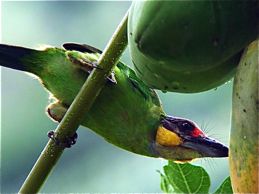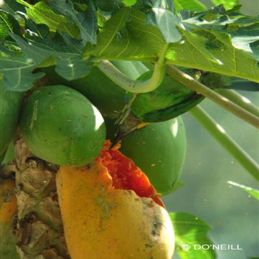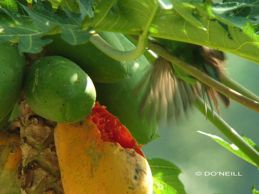At 30cm, the residential Gold-whiskered Barbet (Megalaima chrysopogon) is one of the largest of Megalaimidae’s 16 species of South East Asian barbets. Their rapid ‘tehoop-tehoop-tehoop- tehoop’ extraordinary loud, hollow calls often betray their presence – otherwise well camouflaged by their mostly green plumage under tree canopies (above left & middle).
Barbets are known frugivores, gorging on any edible fruits they can find. I had several opportunities to view some species relishing them at fruiting trees through a digiscope while looking out for opportunities to documenting other abnormal feeding habits as well.
Papaya (Carica papaya) trees grow aplenty in the tropics. The oval shaped fruits are produced in multiples. They are found grown in home gardens, villages and commercial orchards. It is one of the favourite, affordable, local and fresh fruit deserts eaten in Malaysian homes.
Skins of this popular fruit turn yellow upon ripening. Given the opportunity to ripen on trees, it is pay day for a host of variety species of birds.
When a member, contributor posted an article with a first record shot of a Gold-whiskered Barbet eating papaya, I sat up! “What! A feeding record? Good for you Dr Redzlan!
Isn’t it strange that a bird species such as the Gold-whiskered Barbet seen commonly in Malaysia eating papaya – a fruit more commonly to be had, could make it to a new record – to the list of fruits eaten by the species, and no one else been paying attention in the past, not even bird scientists?
So, in I threw my two cents worth of a couple of images to substantiate further, my honourable and contributor colleague’s record. Our administrator, YC was quick to the mark to commend that bird observers should document everything regardless how trivial they are. Yes Sir! I agree.
Well, I guess I owe readers a dig into my bird photo gallery to see what I can find, to detail and document not one but two species of barbets in the last several months, found to be eating papayas. Also, the opportunity to observe their feeding habits, their temperance and the pecking order that followed those observations.
My first documentary shot came at 1031hs on 11th January, 2007 in a Malaysian village. I thought little of the mediocre image, so I put it to sleep in my bird gallery (above right).
27th June, 2008 provided another chance sighting of a resident Gold-whiskered Barbet. It came from a private fruit orchard. Sequential shots were taken between 1019hs-1026hs (below).
I was just warming up.
A follow through observation was made two days later and a shot was delivered showing a hungry barbet feeding. What a glutton he was to possessively grab a chunk of the succulent fruit with his left claw; clung on the tree trunk with his right footed zygodactylous toes and demolishing another chunk of fleshy papaya breakfast in his honky beak (below left)!
This Tai Kor (big brother in Cantonese dialect) got style!
It raised half of my eyebrow this time.
The 3rd sighting came on 22nd Nov. 2008, when I was drawn intuitively to revisit the same fruit orchard. I made a point to be there before 0800hs –‘Mission Undercover’. My timing could not have been better!
The first bright, morning wake up call came after 0800hs as anticipated. Tai Kor announced his presence by exercising his vocal cords for several minutes in exchanged greetings with another other or his mate. He finally made a fluttering dash from his roost to a low broad-leaved tree- a staging area to prepare a launch on his breakfast when my back was turned.
I was standing about 15 feet from the staging area where Big Bro flew in and perched on the branch at 0959hs. I froze. A rare eye level, opportunity shot of him eyeing and contemplating his strategy of approach to his vested interests resulted (above right).
Now I was talking to ‘Big Bro’ with my ‘London Eye’ DGScope. Some studio like profiles came through, showing some handsome yet demurring looks of the Gold-whiskered Barbet. Tai Kor was too engrossed in protecting his treasure trove of ripe and succulent papayas –spoilt for choice to take much notice of me.
At 1010hs, Big Bro flew into the papaya tree and perched onto stemmed foliage as seen in Image 2 for a surveillance check. Ten minutes later, he flew for a closer inspection of the fruits and another cautious surveillance check was made before commencing feeding (right).
It appears this species of barbet is an ‘After 8’ morning feeder and is a shy bird to feed under known observation.
Having had his fill, the barbet did not fly away but stayed around the tree to engage in sentry duties under shade of a spoke like foliage (below left).
Occasionally, he would return for a symbolic peck and indulgence of the fruits. At other times, would fly to his shady, staging area for a quick snooze as expressed by his nictitating membrane, at the same time trying hard to possessively stay awake to watch his fruits (above right)!
Tai Kor was seen to hastily chase off his mate. No other fruit eating species of smaller birds present around dared or were allowed to perch on the same tree.
“Oi! This tree… and all these fruits are MINE, MINE and MINE!”
Do readers think Big Bro would cower to a Phaenicophaeus species?
It was observed there was no occasion where the barbet clang on any fruit, papaya or larger sized fruit to feed. It preferred to approach the fruit by clinging to tree trunks, branches or foliage stems itself and reached out for the fruits instead; barbet turned upside down or otherwise (left).
What transpired was an interesting observation of how the acrobatic bird with its antics, managed to get the fruit beyond his reach as captured in the following stunt photo images taken between 1112hs and 1116hs.
His first strategy was a defying gravity of ‘one foot stand ’job (above). His second strategy was a hovering butterfly act (below).
Both seemed to have worked though lacking in grace but who cares…… barbets never professed to be couth and graceful birds anyway!
It was also observed that the Gold-whiskered Barbet was also selective in his pickings. Where there were better and fresh choices to be had, he did not waste time to peck on new, whole ripened fruits.
The stale, shrivelled looking papaya fruit as seen in this image was left to be swamped by fruit flies (below left).
The greatest joy of this article was to have Tai Kor providing quite an instant result in his indulgence, by catching him doing a ‘poo’ in his feeding area, with evidence of fruit residue still left on his beak (below right).
As for seed dispersal, only fleshy fruit succulents were seen taken. The possibility of Big Bro ingesting the black seeds attached to the inner lining of the fruit cannot be discounted.
If Dr Redzlan’s image of papaya is a new food record for Gold-whiskered Barbets, this image, ‘Papaya in Papaya out’ shot must surely be a proof record shot of the end result provided by yours truly-Avian Writer in collaboration with Tai Kor, Papaya and DGScope.
Join me again soon to enjoy another documentation article follow up of my signature theme for frugivorous barbets, ‘Of …. (Fruits) &….Barbets’.
AVIAN WRITER DAISY O’NEILL PENANG MALAYSIA
© OF PAPAYAS AND GOLD-WHISKERED BARBETS
Optics used: Fieldscope ED82 + 30x + Coolpix P4





